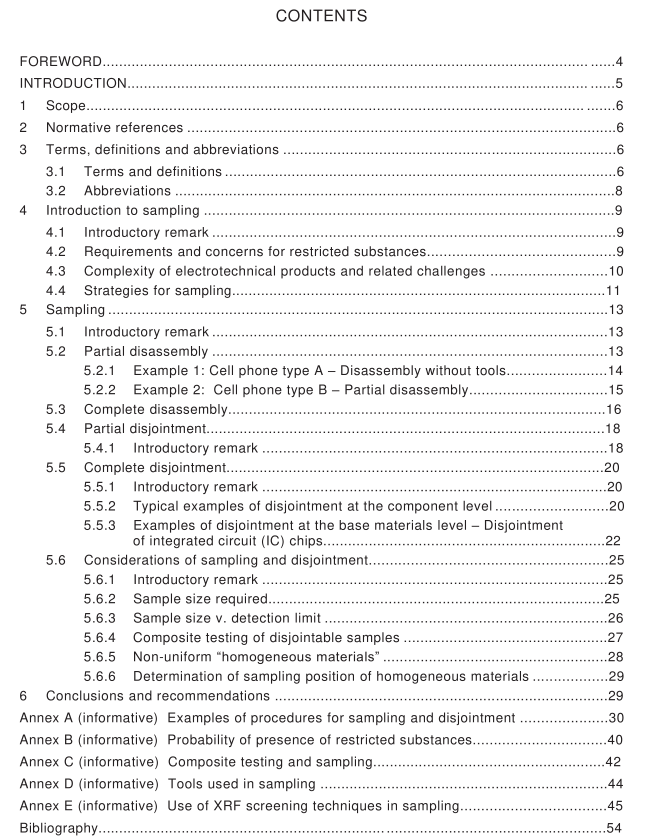DD IEC PAS 62596 pdf – Electrotechnical products – Determination of restricted substances – Sampling procedure – Guidelines

DD IEC PAS 62596 pdf – Electrotechnical products – Determination of restricted substances – Sampling procedure – Guidelines
4. Applicable exemptions: Some types of electrotechnical products are exempt from restricted substances requirements. These exemptions may be based on different rationales including the scope of the restrictions (e.g. for military purposes), the application of the material (e.g high melting temperature solder), size of the sample, or the electrical properties of the product. 4.3 Complexity of electrotechnical products and related challenges The complex characteristics of electrotechnical products are another important consideration when preparing a sampling strategy. These characteristics have a bearing on the practical execution of sampling and analysis.
The following elements are identified as relevant to analysis and sampling:
1 . Miniaturization: Miniaturization is one of the key trends in the electrotechnical industry. This implies that more functionality is provided within a smaller volume. More and more components and materials are used per cm² of printed wiring board (PWB) every year. Taking samples for measurement from these small amounts of material is difficult. For example, the size of surface mounted devices (SMDs) is too small for regular tools to further disjoint or separate and the quantity of the remaining sample is often too small after disjointment to satisfy the requirements of adequate analysis.
2. Number of homogeneous materials: Many components have complex structures and are constructed of multiple layers of different materials. In a typical case, one single component has more than 1 0 to 20 material layers, whereas many electrotechnical products or assemblies contain hundreds or thousands of components. This means one electrotechnical product can have more than 1 000 to more than 1 0 000 homogeneous materials. Often homogeneous materials adhere too tightly together for a clean separation in a practical manner (see Figure 1 5). Experience has shown that the composition often changes due to molecular diffusion between materials (e.g. the composition of a plating is affected by a base material containing Pb). Similarly, current electrotechnical products are made of many components and parts. A typical TV or laptop computer for example, contains thousands of parts/components. Hence the design database for an OEM may include several tens of thousands of components. In Clause 5 this point is further illustrated in the disassembly of a mobile phone.
3. “Invisible” substances: Another complicating factor in sampling and analysis is that generally restricted substances are not visibly apparent. A component containing a restricted substance looks and performs in an identical manner to one that is “clean”. The presence or absence of restricted substances can vary from lot to lot in the manufacturing process without any readily observable clues. While there are some visible indications (e.g. a yellow coating on steel products suggests the presence of hexavalent chromium) as to the presence of restricted substances, visual detection is not practical.
4. Batch–to-batch variations: Most product assembly manufacturers use commodity components from several suppliers simultaneously, e.g. cables, resistors and capacitors. Commodity components are mixed during production, because technically they are fully interchangeable as long as they fit the umbrella specification. However in most cases they are not chemically identical. Furthermore experience has shown that base materials can be changed by commodity manufacturers (e.g. in times of shortage) which leads to a change in the chemical composition as well. Notifications of these changes do not always occur if the component still meets its technical specification. 5. Depth of the supply chain: Producing electronic components/parts involves a complex supply chain. Relatively simple products such as an external cable, can utilize supply chains at least seven tiers deep. The supply chain for a more complex component like an LCD screen or IC is considerably deeper.
These characteristics of the electrotechnical industry show that the management of restricted substances, along with sampling and analysis, is not straightforward. The size and number of components, and complexity of the supply chain make it challenging to fully grasp the locations of restricted substances in an electrotechnical product. The prospect of implementing homogeneous material level sampling and testing at the upper regions of the supply chain (towards finished products) is not practical for complex products.









